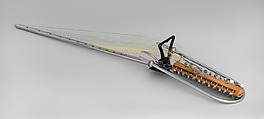Gravikord
Bob Grawi American
An electro-acoustical, minimalist adaptation of the West African kora, the gravikord was patented in 1984 after developing from prototypes made as early as 1974. It and its African forerunner have vertically notched bridges that aligns the 24 color-coded strings in a harp-like fashion and allows the player to pluck them with the fingers while holding the handles at each side. The electronically amplified instrument features a variable pitch device operated by a crossbar under the bridge.
Bob Grawi, the designer and maker of the Gravikord, describes the variable pitch mechanism as follows:
"The bridge is stably supported by four knife-edge pivot. When the right-hand bridge handle is pulled the bridge platform rocks to the right on the two right side pivots, resulting in the left-hand rank of strings raising in pitch, while the right-hand rank lowers in pitch. When the left handle is pulled the opposite occurs. This allows the player to easily raise or lower the pitch of any string desired. The string tension on the bridge is quite high, so that the rank of strings lowering in pitch actually contribute their pressure in helping to reduce the force needed y the player to vary pitch. This is a unique pitch bending system found only on this instruments."
Due to rights restrictions, this image cannot be enlarged, viewed at full screen, or downloaded.

